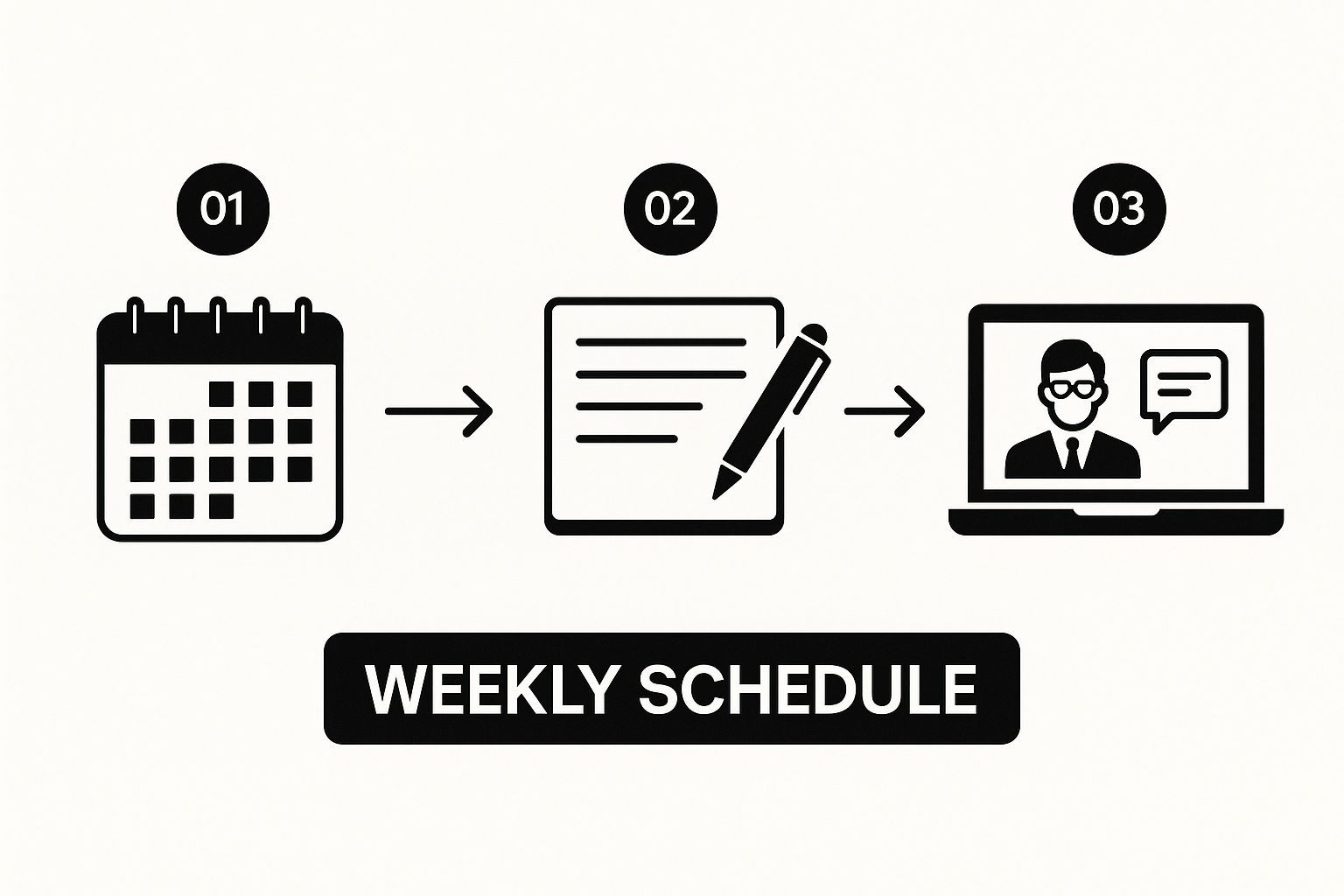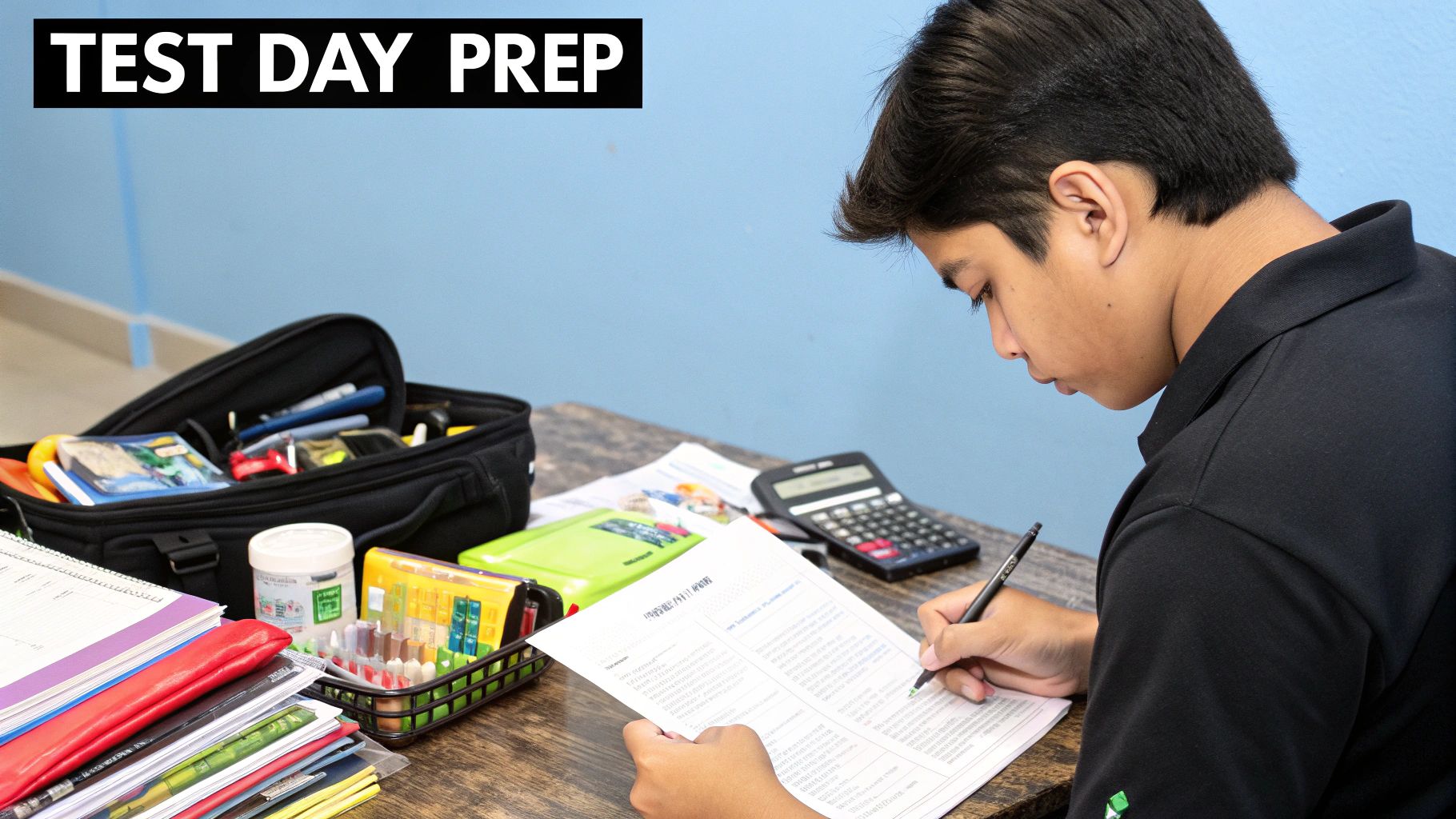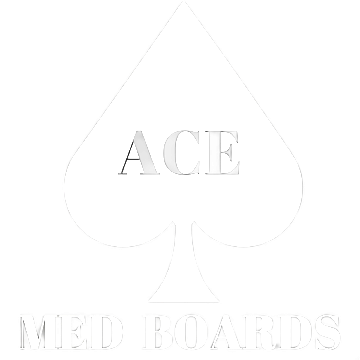A solid Step 1 USMLE study plan isn't about jumping straight into UWorld on day one. Far from it. Real success comes from building a smart, personalized framework before the grind begins. It all hinges on an honest look at where you're starting, a realistic timeline, and a handful of high-yield resources that actually work for you—not just what your classmate is using.
Building Your Foundational USMLE Study Framework

Before you even think about mapping out your first week, you need a blueprint. This foundational stage is where you make the big-picture decisions that will shape your entire dedicated study period. Trying to skip this part is like building a house without a foundation—it’s just not going to hold up under pressure.
Start with an Honest Self-Assessment
First thing's first: you need to know where you stand. Grab an older NBME self-assessment and take it cold. The point isn't to ace it; it's to get a raw, unfiltered snapshot of your baseline. This data is gold because it immediately flags your weakest subjects and gives you a real sense of the mountain you need to climb.
Once you have that baseline score, you can realistically set a test date. A dedicated period of 6 to 10 weeks is pretty standard. If your diagnostic score was strong, six weeks might be all you need. But if you uncovered some serious content gaps, stretching it to eight or even ten weeks can give you the breathing room you need to learn the material properly, without burning out.
Choose Your Core Resources Wisely
The sea of Step 1 resources is overwhelming. Don't fall into the trap of trying to use everything. You only need a few core tools. Think of it as your primary toolkit.
- Question Bank (UWorld or Amboss): This is non-negotiable. UWorld is the gold standard for a reason—its questions and explanations are legendary for mimicking the real exam. Amboss is a fantastic alternative, especially with its integrated library feature. Just pick one and go all in.
- Centralized Text (First Aid): First Aid for the USMLE Step 1 should become your bible. You’ll be annotating it constantly with notes and diagrams from your Qbank and videos. Over time, it transforms into your own personalized, high-yield study guide.
- Video Platform (Pathoma or Boards and Beyond): You absolutely need one of these to build a deep conceptual understanding. They are lifesavers for tricky subjects like pathology and physiology, where rote memorization just won't cut it.
The secret is to master a few high-yield resources, not just skim the surface of a dozen. You’re aiming for depth, not breadth. Focus on powerful techniques like active recall to really make the information stick. You can learn more about how to do that with our guide on https://acemedboards.com/active-recall-for-medical-students/.
Beyond your study materials, your framework needs to account for the mental marathon ahead. It's crucial to learn how to build mental resilience to get through the grind.
Even with the switch to pass/fail, this exam is no walk in the park. The rigor is still there. In 2023, pass rates were 90% for US MD students and 86% for DO students—a noticeable dip from the pre-2022 years. This trend makes it clear: while the score reporting has changed, the need for a rock-solid preparation strategy is as critical as ever.
Crafting Your Week-by-Week Study Schedule
Alright, you’ve got the big picture. Now it's time to get granular and build a concrete, week-by-week schedule. This isn't about downloading a generic template and hoping for the best. The goal is to create a personalized Step 1 USMLE study plan that actually works for you—your energy levels, your learning quirks, and your specific areas of weakness.
Think of your schedule as your best defense against burnout. A solid, adaptable plan keeps you efficient and prevents you from spinning your wheels.
Designing a Sustainable Daily Routine
A balanced daily rhythm is your best friend during dedicated study. Mixing up your study methods prevents mental fatigue and helps you engage with the material from different angles. It's about creating a predictable flow that becomes second nature.
Here’s a structure many students find effective:
- Morning (Fresh Brain): Start with content-heavy resources like Pathoma or Boards and Beyond. Focus on one organ system, like cardiology or renal. This kind of passive learning is often easier when your mind is sharpest.
- Afternoon (Active Integration): Time to switch gears. Open up First Aid to the section you just covered. Your mission is to annotate it with high-yield points from the videos and any related Anki cards. This transforms First Aid from a generic textbook into your personal, supercharged review guide.
- Late Afternoon/Evening (Application): Now for the most important part—a timed, 40-question UWorld block. But doing the questions is only half the battle. The real learning happens in the review. Don't just check what you got wrong; dig deep into why you got it wrong. And don't skip the explanations for the questions you got right, either! You'll often pick up pearls you missed.
This daily cycle—learn, integrate, apply—is incredibly powerful. This infographic breaks down how these pieces fit together over a week.

As you can see, each part of the day builds on the last, creating a powerful loop of learning and reinforcement.
Evolving Your Focus Over Time
Your study schedule can't be set in stone. It has to evolve with you. In the beginning, your focus will be heavy on content review. But as you get closer to exam day, you need to pivot hard toward intensive practice.
For a great example of how this looks over a longer period, check out this excellent USMLE Step 1 preparation timetable. It gives you a bird's-eye view of how to structure your entire dedicated period.
I see students make this mistake all the time: they spend way too long on content review and not nearly enough time on practice questions. Remember, Step 1 tests your ability to apply knowledge in clinical vignettes, not just spit back isolated facts. Your schedule has to reflect that.
So, how does this evolution actually look in practice? The table below gives a sample framework for a 6-week dedicated study block. It shows how your daily goals and activities should shift as you build momentum toward your test date.
Sample 6-Week Dedicated USMLE Step 1 Study Period
This template is designed to help you shift your focus from building a strong knowledge foundation to stress-testing that knowledge under exam-like conditions.
| Study Phase | Weekly Focus | Daily Q-bank Goal | Key Activities |
|---|---|---|---|
| Weeks 1-2 | Content Foundation | 40 Questions (1 Block) | Watch videos, annotate First Aid, complete daily Anki reviews, and conduct a thorough review of one UWorld block. |
| Weeks 3-4 | Weakness Targeting | 80 Questions (2 Blocks) | Take the first NBME practice exam, identify weak systems, and dedicate extra time to those subjects. |
| Weeks 5-6 | Exam Simulation | 120 Questions (3 Blocks) | Take UWSA 1 & 2 and the Free 120. Focus on timing, stamina, and reviewing incorrects from all practice tests. |
Think of this as a road map. You start by paving the road (content), then you learn how to drive on it (targeted practice), and finally, you take it for a high-speed test drive (full simulations).
Picking Your Tools: How to Select and Master High-Yield Resources
Let's be honest—the sheer number of USMLE resources out there is overwhelming. It’s easy to fall into the trap of thinking more is better, but building an effective Step 1 USMLE study plan is about quality over quantity. Your real goal should be to pick a handful of top-tier tools and know them inside and out, creating a focused toolkit where every resource serves a purpose.
For years, the "UFAPS" combination has been the gold standard, and for good reason. UWorld, First Aid, Pathoma, and SketchyMedical work together beautifully, hitting the material from every critical angle—conceptual understanding, factual recall, and clinical application.
The Core Trio: UWorld, First Aid, and Pathoma
Think of these three as the bedrock of your daily study routine. UWorld isn't just a Qbank for self-assessment; it's your primary learning tool. The magic is in the explanations—that's where the deep learning happens.
The single biggest mistake students make is treating UWorld like a final exam instead of a dynamic textbook. Every single question, whether you get it right or wrong, is a learning opportunity. The explanation is almost always more valuable than the question itself.
As you grind through UWorld blocks, your mission is to actively integrate what you learn directly into your copy of First Aid. This doesn't mean mindlessly copying facts. Instead, you should be making small, concise annotations, drawing quick diagrams, or jotting down mnemonics in the margins that clarify tricky concepts. Doing this transforms First Aid from a generic review book into your personalized, high-yield bible.
Pathoma slides in to provide the essential "why" behind the diseases, giving you a rock-solid foundation in pathology that makes everything else click.
This screenshot from UWorld’s website shows its classic interface. Pay close attention to the detailed explanations—that's where you'll spend most of your time.
The whole platform is built for deep review, which is why a thorough analysis of every question block is absolutely essential for making progress. For more insights on picking the best question banks, check out our guide on the best USMLE Step 1 practice questions and question banks.
Integrating Sketchy and Anki the Smart Way
When it comes to the brute-force memorization needed for microbiology and pharmacology, SketchyMedical is in a league of its own. Its visual memory palaces make retaining thousands of tedious details not just possible, but surprisingly manageable.
The key to making Sketchy stick is immediate reinforcement. Watch a video, and then immediately follow it up with the corresponding Anki cards to lock in the associations.
This brings us to Anki. Using a comprehensive, pre-made deck like AnKing is a massive time-saver, as it pulls from all the best resources and organizes them into a powerful spaced-repetition system. But be careful—mindlessly flipping through cards is a waste of time. Your daily Anki review needs to be an active process. If you get a card wrong, pause for a moment to figure out why. This commitment to active recall is what truly cements information in your long-term memory.
By combining these resources, you build a streamlined, powerful stack you can truly count on.
How to Track Progress and Adapt Your Plan
A static study plan is a failed study plan. I've seen it time and time again. The students who succeed don't just create a schedule and follow it blindly; they build a living, breathing guide that evolves based on real data.
Think of your plan as a GPS for Step 1. It has to constantly recalculate the best route based on real-time feedback from your practice questions and self-assessments. This proactive feedback loop is what turns a good plan into a great one. It allows you to use hard data to pinpoint weaknesses and systematically turn them into strengths. Without it, you’re just studying in the dark.
Using Data to Steer Your Studying
Your daily Q-bank performance is your most immediate source of information. Pay close attention to your UWorld percentages, but don't obsess over the overall average. The real gold is in the performance tab, where you can break down your scores by subject and system.
A consistent dip below 50% in a specific area, like cardiology or renal, is a huge red flag. This data is your early warning system, showing you where the cracks in your foundation are long before they become major problems on a practice exam.
Your Q-bank isn't just a testing tool; it's a diagnostic tool. Treat every incorrect answer not as a failure, but as a specific, actionable piece of data telling you exactly what you need to study next.
The Role of NBME Self-Assessments
While UWorld is great for tracking daily progress, the NBME (National Board of Medical Examiners) self-assessments provide those crucial, big-picture snapshots of your readiness. I always recommend students take their first NBME about two to three weeks into their dedicated study period. This gives you enough time to have covered a good chunk of material but leaves plenty of runway to adapt your strategy.
After you finish an NBME, resist the urge to just glance at the three-digit score and move on. Dive deep into the performance report. Your mission is to identify the two or three systems where you performed the worst. This is where you’ll focus your energy for the upcoming week.
Let’s walk through a real-world scenario I've seen countless times:
- The Data: Your NBME score is decent, but the report shows you got hammered on questions related to Cardiology and Renal/Urinary systems.
- The Adaptation: For the next 5-7 days, you're going to pivot your schedule. Your morning content review sessions will be dedicated exclusively to these two systems. Pull out Pathoma, fire up Boards and Beyond—whatever it takes.
- The Action Plan: Now, you hit UWorld with purpose. You’ll create custom, timed blocks of 20-40 questions composed entirely of Cardiology and Renal questions. This kind of targeted practice forces you to apply the concepts you're reviewing, cementing them in your brain.
This cycle of assessment, analysis, and adaptation is the engine of an effective study plan. It ensures every hour is spent as effectively as possible.
And remember, tracking progress isn't just about the numbers. Mental stamina is just as important as content mastery. Burnout is real, and it will tank your score faster than any knowledge gap. Explore effective strategies to reduce chronic stress to ensure you stay sharp and avoid hitting a wall.
Navigating the Final Weeks and Test Day

As you hit the two-week mark on your Step 1 USMLE study plan, the mission changes. You're no longer trying to learn new material; the goal now is to consolidate everything you've already packed into your brain. This is absolutely not the time for heroic, 12-hour cram sessions. That’s a fast track to burnout.
Instead, it's time to start tapering your study hours and shifting your focus to high-yield, targeted review. Your energy is best spent on quick-hit reviews of the subjects that are notoriously difficult to keep straight. Think biochemistry pathways, those dense microbiology charts, and pharmacology mechanisms. This isn't about re-learning; it's about keeping the most critical facts fresh and at the front of your mind.
Final Preparations and Simulation
In the last week, one of the most valuable things you can do is take the Free 120 exam. To get the most out of it, book a slot at a Prometric center. This simulates the entire test-day experience—from the slightly awkward check-in process to the feel of the testing environment—which can work wonders for your nerves on the actual day.
The day before your exam is for rest, not review. Seriously. If you feel you absolutely must do something, lightly flip through a few notes, but your main job is to let your mind relax.
Pre-Exam Day Checklist:
- Pack Your Bag: Get your scheduling permit, a valid ID, and some smart snacks (like nuts or a protein bar) together. Don't forget water and any necessary medications.
- Plan Your Dinner: Stick with a familiar, balanced meal that you know won't cause any digestive surprises.
- Set Multiple Alarms: Leave nothing to chance. Set one on your phone, one on an actual clock, and maybe even get a friend to call you.
- Relax: Watch a movie, go for a walk, listen to some music. Do anything that isn't stressful and isn't related to medicine.
The goal is to walk into that testing center feeling confident and rested, not frantic and exhausted. Your performance hinges just as much on your mental state as it does on your knowledge.
Mastering Test Day Itself
On exam day, it’s all about pacing. You have 45 minutes of scheduled break time, plus any time you save by skipping the 15-minute tutorial at the beginning. A classic strategy that works for many is to take a short, 5-minute break after every single block to mentally reset. Use this time to stretch, hit the restroom, and have a quick snack.
And here's a crucial tip: don't let one tough block derail your entire day. Each section is scored independently. If you finish a block feeling completely defeated, take a slightly longer break to clear your head before diving into the next one.
Your ability to maintain mental stamina for the full eight hours is just as important as recalling the Krebs cycle. It’s a marathon, not a sprint, and how you strategically use your breaks is what will get you across the finish line.
Got Questions About Your Step 1 Study Plan? Good.
Even with the best-laid plans, you’re going to have questions. Building a USMLE Step 1 study schedule is a deeply personal process, and it’s completely normal to wonder if you’re doing it right. Let’s tackle some of the most common questions I hear from students, cutting through the noise to give you clear, actionable answers.
How Long Should My Dedicated Study Period Be?
This is the big one, and the honest-to-goodness answer is: it depends. There's no magic number.
For most med students, the sweet spot for a dedicated study period lands somewhere between 6 and 10 weeks. The right length for you really comes down to how strong your foundation is coming out of your pre-clinical years.
Did you feel pretty solid in your classes and generally do well? Then 6 to 8 weeks is likely enough time to zero in on integrating concepts and crushing practice questions. But if your self-assessment flagged some serious content gaps, stretching your plan to 10 weeks is a smart move. That extra time lets you shore up your knowledge without the constant feeling of being behind.
My biggest piece of advice here: don't stretch your dedicated period much beyond 10 weeks. I've seen it time and time again—the risk of burnout goes through the roof, and you actually start forgetting what you learned in the first few weeks. The goal is to peak on exam day, not crawl across the finish line.
How Many Practice Questions Should I Do Every Day?
During dedicated, a solid daily target is 80 to 120 questions. That usually breaks down into two or three 40-question blocks. When you're just starting, you might only get through one block a day, and that's perfectly fine. You'll ramp up as you get more efficient.
But here's the crucial part: the number of questions you do is way less important than the quality of your review.
The most valuable part of your day is the deep dive into the explanations for every single question—especially the ones you got right. A thorough, high-quality review of one 40-question block is infinitely better than rushing through three blocks just to hit an arbitrary number.
When Should I Take My First Practice Exam?
Think of practice exams as your GPS. They tell you where you are, where you're going, and how to get there. I recommend taking a baseline practice exam—maybe an older NBME form—before your official dedicated period even starts. This gives you a raw, unfiltered snapshot of your starting point.
Once dedicated begins, get into a rhythm of taking a practice exam every 1 to 2 weeks. This regular check-in is essential for tracking your progress and making smart adjustments to your study schedule.
Here’s how to be strategic about it:
- Early & Mid-Prep: Use the older NBME forms first. They're great for finding your weak spots and hammering them out without burning through your most predictive assessments too early.
- Final 2-3 Weeks: This is when you break out the heavy hitters. Save the most predictive exams for the home stretch. We're talking about the UWorld Self-Assessments (UWSAs) and the Free 120. These will give you the most accurate feel for where you stand right before the real deal.
This tiered approach ensures you’re using the right tool for the job at every stage of your prep.
Feeling stuck or need a personalized strategy to get you over the finish line? The expert tutors at Ace Med Boards specialize in creating custom study plans that deliver results. Start with a free consultation today to see how we can help you ace your exam.
